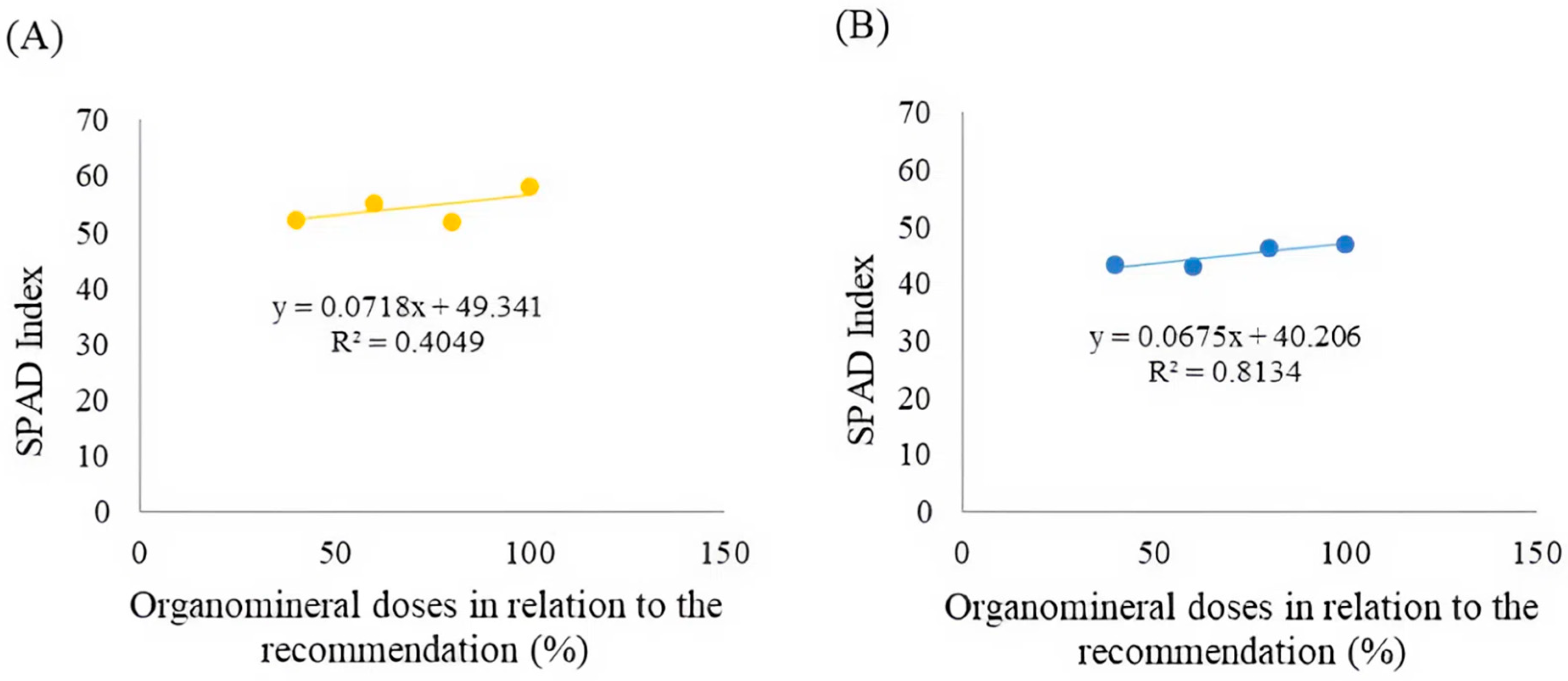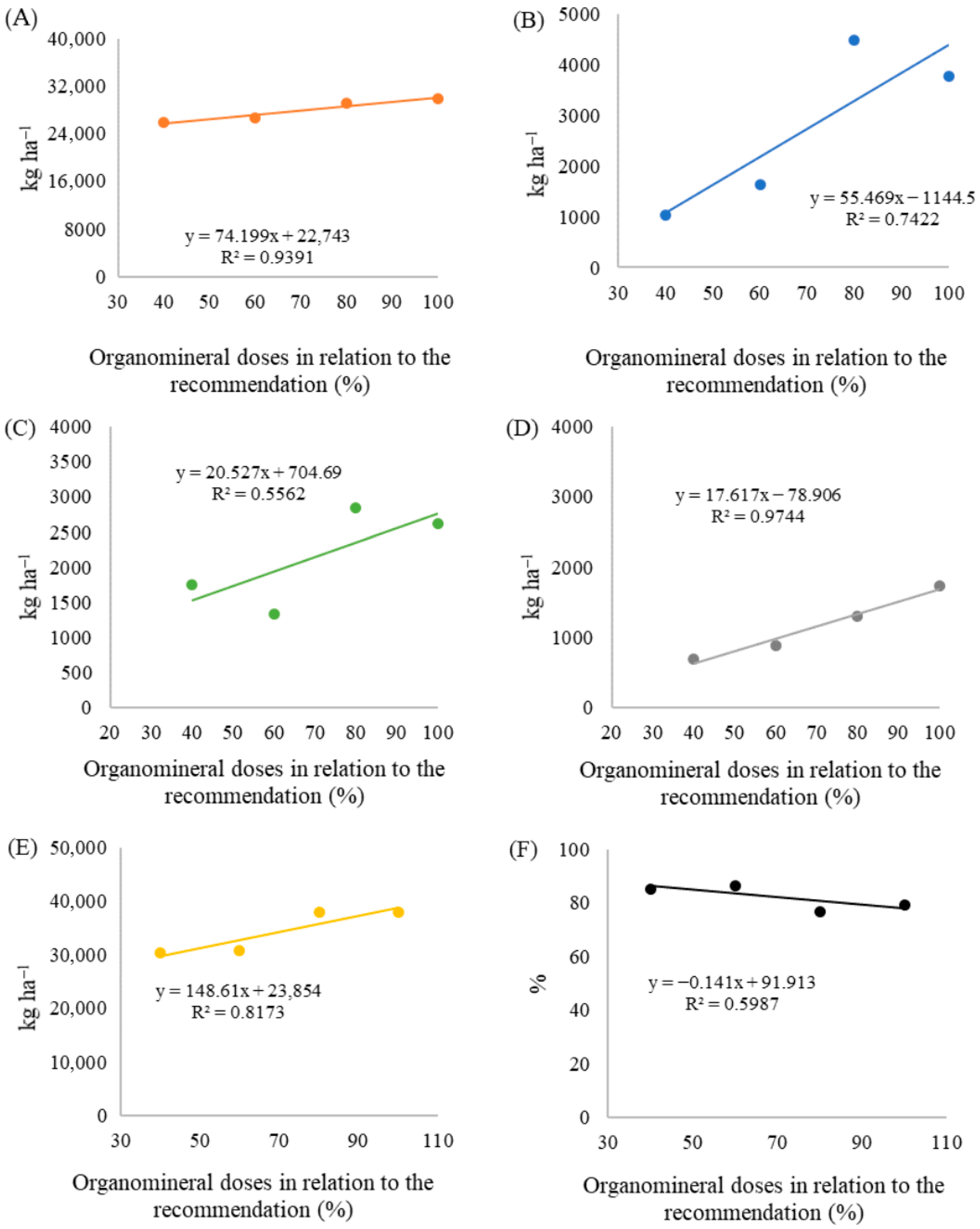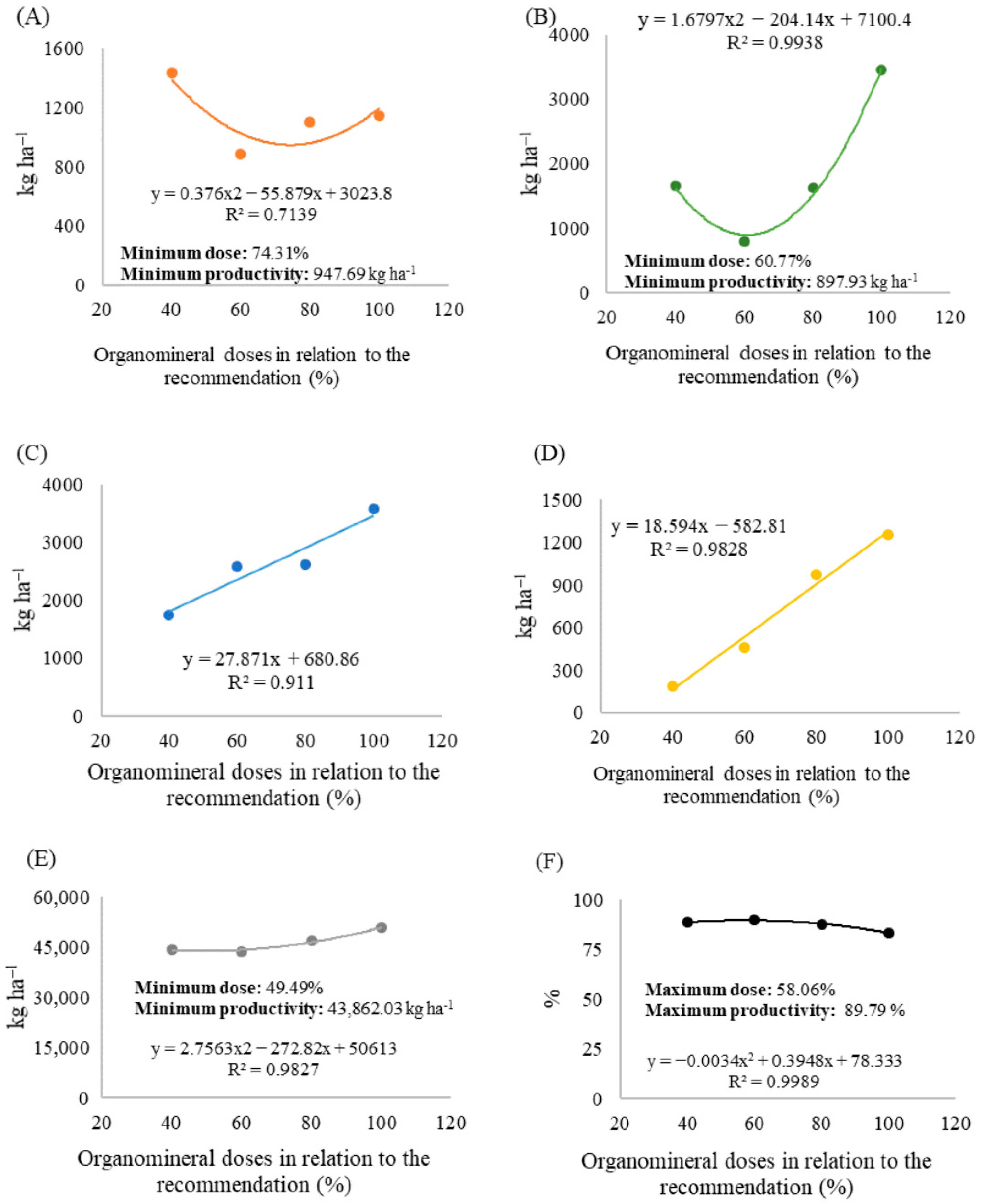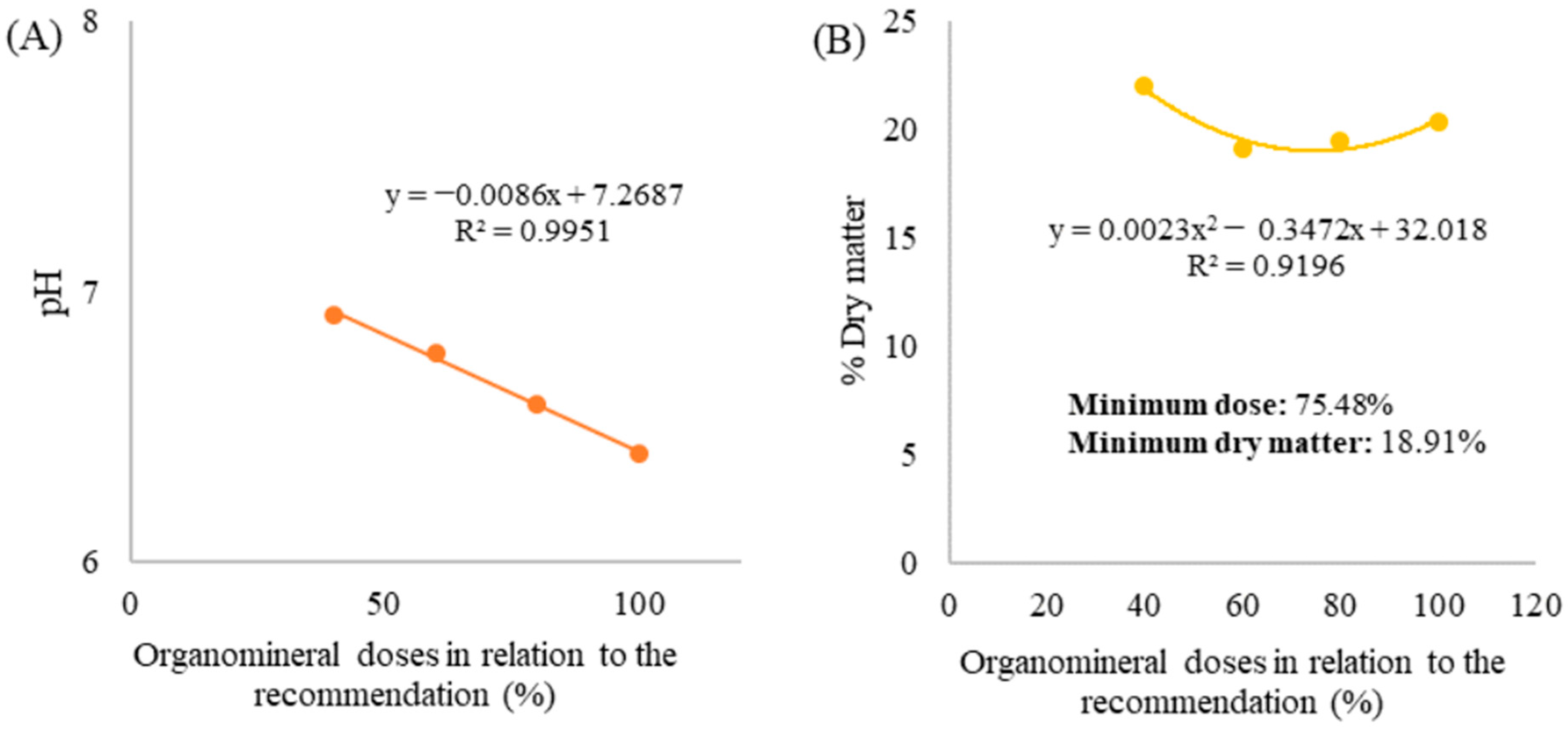Organomineral Fertilizer in Planting of Potato Cultivars Ágata and Atlantic
Abstract
1. Introduction
2. Materials and Methods
2.1. Site and Soil Characterization
2.2. Experimental Design
2.3. Characterization of Fertilizer Sources
2.4. Variables Evaluated
2.4.1. SPAD Index at 48, 62, 76 and 91 Days After Planting
2.4.2. Tuber Classification and Productivity
2.4.3. Dry Matter, pH, and Carbohydrates in Tubers
2.5. Statistical Analysis
3. Results
3.1. SPAD Index as a Function of Organomineral Fertilizer Dose
3.2. Tuber Classification and Productivity According to the Application of Organomineral Fertilizer
3.3. Dry Matter, pH, Carbohydrate, and Solid Content in Tubers Resulting from Organomineral Fertilization
4. Discussion
4.1. SPAD Index
4.2. Tuber Classification and Productivity
4.3. Dry Matter, pH, Carbohydrate, and Solid Contents in Tubers
5. Conclusions
Author Contributions
Funding
Data Availability Statement
Conflicts of Interest
References
- IBGE (Instituto Brasileiro de Geografia e Estatística). Levantamento Sistemático da Produção Agrícola. Estatística da Produção Agrícola. February 2021. Available online: https://biblioteca.ibge.gov.br/visualizacao/periodicos/2415/epag_2021_fev.pdf (accessed on 26 April 2024).
- Soratto, R.P.; Fernandes, A.M. Resposta da cultura da batata à adubação fosfatada no Brasil. In Informações Agronômicas nº157; International Plant Nutrition Institute: Peachtree Corners, GA, USA, 2017; p. 8. [Google Scholar]
- Lopes, C.M.; Silva, A.M.M.; Estrada-Bonilla, G.A.; Ferraz-Almeida, V.R.; Vieira, J.L.V.; Otto, R.; Vitti, G.C.; Cardoso, E.J.B.N. Improving the fertilizer value of sugarcane wastes through phosphate rock amendment and phosphate-solubilizing bacteria inoculation. J. Clean. Prod. 2021, 298, 126821. [Google Scholar] [CrossRef]
- Oliveira, R.C.; Silva, J.E.R.; Aguilar, A.S.; Peres, D.; Luz, J.M.Q. Uso de fertilizante organomineral no desenvolvimento de mudas de rúcula. Agropecuária Científica No Semiárido 2018, 14, 1–6. [Google Scholar] [CrossRef]
- Cruz, A.C.; Perreira, F.S.; Figueredo, V.S. Fertilizantes organominerais de resíduos do agronegócio: Avaliação do potencial econômico brasileiro. Indústria Química BNDES Setorial 2017, 45, 137–187. [Google Scholar]
- CONAB. Available online: https://www.gov.br/conab/pt-br/atuacao/informacoes-agropecuarias/safras/safra-de-cana-de-acucar/arquivos-boletins/1o-levantamento-safra-2025-26/boletim-cana-de-acucar-4o-levantamento-2025-26 (accessed on 20 May 2025).
- Carpanez, T.G.; Moreira, V.R.; Assis, I.R.; Amaral, M.C.S. Vinhaça de cana-de-açúcar como matéria-prima para fertilizantes organominerais: Oportunidades e riscos ambientais. Sci. Total Environ. 2022, 37, 154998. [Google Scholar] [CrossRef] [PubMed]
- Kamboj, A.; Sadh, P.K.; Yadav, B.; Kumari, A.; Kumar, R.; Saharan, B.S.; Brar, B.; Kumar, D.; Goyal, C.; Duhan, J.S. Unravelling the potential of sugarcane bagasse: An eco-friendly and inexpensive agro-industrial waste for the production of valuable products using pretreatment processes for sustainable bio-economy. J. Environ. Chem. Eng. 2024, 12, 114461. [Google Scholar] [CrossRef]
- Soares, A.A.V.L.; Prado, R.M.; Bertani, R.M.A.; Silva, A.P.R.; Deus, A.C.F.; Kano, C.; Furlaneto, F.P.B. Contribution of Using Filter Cake and Vinasse as a Source of Nutrients for Sustainable Agriculture—A Review. Sustainability 2024, 16, 5411. [Google Scholar] [CrossRef]
- Borges, B.M.M.N.; Abdala, D.B.; Souza, M.F.; Viglio, L.M.; Coelho, M.J.A.; Pavinato, P.S.; Franco, H.C.J. Organomineral phosphate fertilizer from sugarcane byproduct and its effects on soil phosphorus availability and sugarcane yield. Geoderma 2019, 339, 20–30. [Google Scholar] [CrossRef]
- Kotelnikova, A.; Matveeva, N.; Borisochkina, O.R.; Volkov, D.S.; Savichev, A. Organomineral fractions as a way to assess the chemical transformation of elements in soils of different cultivation. Soil Till. Res. 2024, 242, 106141. [Google Scholar] [CrossRef]
- Cardoso, A.F.; Luz, J.M.Q.; Lana, R.M.Q. Produtividade e qualidade de tubérculos de batata em função do fertilizante organomineral e safras de plantio. Rev. Caatinga 2015, 28, 80–89. [Google Scholar] [CrossRef]
- Donagema, G.K.; Campos, D.V.B.d; Calderano, S.B.; Teixeira, W.G.; Viana, J.H.M. Soil Analysis Methods Manual, 2nd ed.; Embrapa Solos: Rio de Janeiro, Brazil, 2011; p. 230. [Google Scholar]
- Minolta Camera. Manual for Chlorophyll Meter SPAD-502; Minolta Radiometric Instruments Division: Osaka, Japan, 1989; p. 22. [Google Scholar]
- Zenebon, O.; Pascuet, N.S.; Ticlea, P. Métodos Físico-Químicos Para Análise de Alimentos; Instituto Adolfo Lutz: São Paulo, Brazil, 2008; p. 1020. [Google Scholar]
- AOAC (Association of Official Analytical Chemists); Helrich, K. (Eds.) Official Methods of Analysis; Association of Official Analytical Chemists: Washington, DC, USA, 1990; Volume 2, p. 700. [Google Scholar]
- Cecchi, H.M. Fundamentos Teóricos e Práticos em Análise de Alimentos; UNICAMP: São Paulo, Brazil, 2003; p. 207. [Google Scholar]
- IBM Corp. IBM SPSS Statistics for Windows, Version 22.0; IBM Corp.: Armonk, KY, USA, 2013. [Google Scholar]
- Ferreira, D.F. SISVAR—Um sistema computacional de análise estatística. Ciência Agrotecnol. 2011, 35, 1039–1042. [Google Scholar] [CrossRef]
- Fernandes, F.M.; Soratto, R.P.; Fernandes, A.M.; Souza, E.F.C. Chlorophyll meter-based leaf nitrogen status to manage nitrogen in tropical potato production. Agron. J. 2021, 113, agj2.20589. [Google Scholar] [CrossRef]
- Malavolta, E.; Vitti, G.C.; Oliveira, S.A. Avaliação do Estado Nutricional das Plantas: Princípios e Aplicações, 2nd ed.; Potafós: Piracicaba, Brazil, 1997; p. 319. [Google Scholar]
- Teixeira, W.G.; Souza, R.T.X.; Korndörfer, G.H. Resposta da cana-de-açúcar a doses de fósforo fornecidas por fertilizante organomineral. Biosci. J. 2014, 30, 1729–1736. [Google Scholar]
- Delvaux, J.C.; Camargo, R.; Franco, M.H.R.; Stanger, M.C.; Gonçalves, R.A.; Lemes, E.M.; Miguel, P.S.B. Soil quality bioindicators in initial eucalyptus growth under organomineral fertilization based on sugarcane filter cake. Aust. J. Crop Sci. 2021, 15, 602–609. [Google Scholar] [CrossRef]
- de Oliveira, R.C.; Almeida, R.F.; Oliveira, P.L.S.; Silva, J.R.; Luz, J.M.Q. Organomineral as a substitute for mineral fertilization in potato cultivation. Comun. Sci. 2023, 15, e4121. [Google Scholar] [CrossRef]
- Cardoso, A.D.; Alvarenga, M.A.R.; Dutra, F.V.; Melo, T.L.; Viana, A.E.S. Características físico-químicas de batata em função de doses e fracionamentos de nitrogênio e potássio. Rev. Ciências Agrárias 2017, 3, 567–575. [Google Scholar] [CrossRef]
- Licciardello, F.; Lombardo, S.; Rizzo, V.; Pitino, I.; Pandino, G.; Strano, M.G.; Muratore, G.; Restuccia, C.; Mauromicale, G. Integrated agronomical and technological approach for the quality maintenance of ready-to-fry potato sticks during refrigerated storage. Postharvest Biol. Technol. 2018, 136, 23–30. [Google Scholar] [CrossRef]
- Evangelista, R.M.; Nardin, I.; Fernandes, A.M.; Soratto, R.P. Qualidade nutricional e esverdeamento pós-colheita de tubérculos de cultivares de batata. Pesqui. Agropecuária Bras. 2011, 46, 953–960. [Google Scholar] [CrossRef]
- Braun, H.; Fonte, P.C.R.; Finger, F.L.; Busato, C.; Cecon, P.R. Carboidratos e matéria seca de tubérculos de cultivares de batata influenciados por doses de nitrogênio. Ciência Agrotecnol. 2010, 34, 285–293. [Google Scholar] [CrossRef]





| Water pH (1:2.5) | pH CaCl2 | P meh−1 | K | S | Ca2+ | Mg2+ | Al3+ | H + Al | CEC |
|---|---|---|---|---|---|---|---|---|---|
| mg dm−3 | cmolc dm−3 | ||||||||
| 5.80 | 5.27 | 9.76 | 116.71 | 10.63 | 3.24 | 1.16 | <0.13 | 5.52 | 10.23 |
| O.M | BS | Al(sat) | B | Zn | Fe | Mn | Cu | SB | |
| g kg−1 | mg dm−3 | cmolc dm−3 | |||||||
| 30.29 | 45.75 | 0 | 0.67 | 11.41 | 41.12 | 19.77 | 0.92 | 4.70 | |
| CaMg−1 | CaK−1 | MgK−1 | CaCEC−1 | MgCEC−1 | KCEC−1 | H + AlT−1 | Sand % | Silt% | Clay% |
| 2.90 | 11.28 | 4.03 | 31.50 | 11.25 | 3.00 | 54.25 | 4.95 | 30.05 | 65 |
| NPK Treatments | Planting Fertilization | Top-Dress Fertilization 350 kg ha−1 20-00-20 | Total Quantity Applied in Cycle | |||||||
|---|---|---|---|---|---|---|---|---|---|---|
| Dose | N | P2O5 | K2O | N | K2O | N | P2O5 | K2O | ||
| kg ha−1 % * | kg ha−1 | |||||||||
| SMF 03-35-06 | 2300 | 100 | 69 | 805 | 138 | 70 | 70 | 139 | 805 | 208 |
| OM 02-20-05 | 3680 | 100 | 74 | 736 | 184 | 70 | 70 | 144 | 736 | 254 |
| OM 02-20-05 | 2944 | 80 | 59 | 589 | 147 | 70 | 70 | 129 | 589 | 217 |
| OM 02-20-05 | 2208 | 60 | 44 | 442 | 110 | 70 | 70 | 114 | 442 | 180 |
| OM 02-20-05 | 1472 | 40 | 30 | 294 | 74 | 70 | 70 | 100 | 294 | 144 |
| Treatments | SPAD Ágata | SPAD Atlantic | ||||||
|---|---|---|---|---|---|---|---|---|
| Recommended Dose Equivalent (%) | Days After Planting | Days After Planting | ||||||
| 48 * | 62 ns | 76 ns | 91 ns | 48 ns | 62 ns | 76 ns | 91 * | |
| Standard-100 | 1 52.7 ab | 49.5 a | 50.0 a | 47.8 a | 61.5 a | 49.8 a | 47.3 a | 42.6 b |
| 100 | 58.1 a + | 51.2 a | 51.6 a | 51.7 a | 56.0 a | 52.2 a | 49.0 a | 46.9 a + |
| 80 | 51.9 b | 50.1 a | 50.9 a | 47.8 a | 55.4 a | 51.6 a | 49.0 a | 46.3 ab + |
| 60 | 55.2 ab | 50.3 a | 49.8 a | 48.4 a | 54.8 a | 51.7 a | 48.6 a | 43.1 ab |
| 40 | 52.2 b | 49.8 a | 49.6 a | 46.9 a | 54.1 a | 51.2 a | 47.6 a | 43.4 ab |
| Treatments | Ágata Classification kg ha−1 | Atlantic Classification kg ha−1 | ||||||||||
|---|---|---|---|---|---|---|---|---|---|---|---|---|
| Recommended Dose Equivalent (%) | Special * | 1st * | 2nd ns | Different * | Jumbo | Discard * | Specials | 1st * | 2nd ns | Different * | Jumbo * | Discard * |
| Standard-100 | 1 30,600 a | 1040 ab | 320 a | 4840 a | 2730 a | 820 a | 42,450 a | 1410 a | 200 a | 1660 b | 1610 b | 410 ab |
| 100 | 29,980 a | 1130 ab | 340 a | 3790 a | 2620 a | 1730 b+ | 42,330 a | 1150 ab | 220 a | 3450 a + | 3580 a + | 1250 c + |
| 80 | 29,240 ab | 1200 ab | 230 a | 4500 a | 2850 a | 1300 ab | 41,140 a | 1100 ab | 430 a | 1620 b | 2630 ab | 980 bc + |
| 60 | 26,620 b + | 980 b | 270 a | 1630 b + | 1343 b + | 890 a | 39,160 a | 880 b + | 250 a | 800 b | 2580 ab | 460 ab |
| 40 | 25,910 b + | 1340 a+ | 290 a | 1040 b + | 1753 ab | 700 a | 39,210 a | 1440 a | 230 a | 1660 b | 1740 b | 190 a |
| Treatments Recommended Dose Equivalent (%) | Ágata | Atlantic | ||
|---|---|---|---|---|
| Total Productivity * | %Special * | Total Productivity ns | % Special * | |
| kg ha−1 | kg ha−1 | |||
| Standard-100 | 1 39,520 a | 77,410 c | 47,330 a | 89,600 a |
| 100 | 37,840 a | 79,220 bc | 50,730 a | 83,370 b |
| 80 | 38,000 a | 76,920 c | 46,910 a | 87,740 a |
| 60 | 30,840 b | 86,630 a | 43,670 a | 89,710 a |
| 40 | 30,320 b | 85,390 ab | 44,270 a | 88,570 a |
| Treatments % | Ágata | Atlantic | ||||
|---|---|---|---|---|---|---|
| Dry Matter | pH | Carbohydrate | Dry Matter | pH | Carbohydrate | |
| g/kg | ||||||
| Standard-100 | 1 114.1 b | 6.50 d | 130.4 a | 223.9 a | 7.12 a | 132.5 ab |
| 100 | 151.4 ab | 6.40 e * | 114.7 ab * | 203.1 ab * | 7.08 a | 136.2 a |
| 80 | 148.0 ab | 6.58 c * | 108.0 b * | 194.8 b * | 6.86 c * | 125.3 b |
| 60 | 161.7 a * | 6.77 b * | 119.1 ab | 191.0 b * | 7.03 ab | 126.3 ab |
| 40 | 155.0 ab * | 6.91 a * | 120.0 ab | 219.8 a | 6.94 bc * | 129.9 ab |
| CV (%) | 3.49 | 0.41 | 5.86 | 4.10 | 0.58 | 2.90 |
Disclaimer/Publisher’s Note: The statements, opinions and data contained in all publications are solely those of the individual author(s) and contributor(s) and not of MDPI and/or the editor(s). MDPI and/or the editor(s) disclaim responsibility for any injury to people or property resulting from any ideas, methods, instructions or products referred to in the content. |
© 2025 by the authors. Licensee MDPI, Basel, Switzerland. This article is an open access article distributed under the terms and conditions of the Creative Commons Attribution (CC BY) license (https://creativecommons.org/licenses/by/4.0/).
Share and Cite
Magela, M.L.M.; Luz, J.M.Q.; Lana, R.M.Q.; Oliveira, R.C.d.; Gontijo, L.N.; Finzi, R.R.; Maciel, G.M.; Siquieroli, A.C.S. Organomineral Fertilizer in Planting of Potato Cultivars Ágata and Atlantic. Agronomy 2025, 15, 1833. https://doi.org/10.3390/agronomy15081833
Magela MLM, Luz JMQ, Lana RMQ, Oliveira RCd, Gontijo LN, Finzi RR, Maciel GM, Siquieroli ACS. Organomineral Fertilizer in Planting of Potato Cultivars Ágata and Atlantic. Agronomy. 2025; 15(8):1833. https://doi.org/10.3390/agronomy15081833
Chicago/Turabian StyleMagela, Mara Lúcia Martins, José Magno Queiroz Luz, Regina Maria Quintão Lana, Rayssa Camargo de Oliveira, Luciana Nunes Gontijo, Rafael Resende Finzi, Gabriel Mascarenhas Maciel, and Ana Carolina Silva Siquieroli. 2025. "Organomineral Fertilizer in Planting of Potato Cultivars Ágata and Atlantic" Agronomy 15, no. 8: 1833. https://doi.org/10.3390/agronomy15081833
APA StyleMagela, M. L. M., Luz, J. M. Q., Lana, R. M. Q., Oliveira, R. C. d., Gontijo, L. N., Finzi, R. R., Maciel, G. M., & Siquieroli, A. C. S. (2025). Organomineral Fertilizer in Planting of Potato Cultivars Ágata and Atlantic. Agronomy, 15(8), 1833. https://doi.org/10.3390/agronomy15081833





